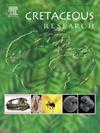A new euornithine from the Lower Cretaceous (Aptian) of China reveals the first radiation of fish-eating birds
IF 1.7
3区 地球科学
Q1 GEOLOGY
引用次数: 0
Abstract
A new euornithine bird, Kunpengornis anhuimusei gen. et sp. nov., is described based on a nearly complete skeleton from the Lower Cretaceous (Aptian) Jehol Biota in western Liaoning, China. The new taxon is characterized by possessing the unique combination of reduced maxillary ramus of premaxilla shorter than half the buccal margin of premaxilla, coracoid having a trapezoidal procoracoid process not expanded craniocaudally at its medial margin, sternum with blunt craniolateral process, drop-shaped distal end of lateral trabecula and reduced intermediate trabecula not enclosing a caudal fenestra, pubis lacking ossified distal symphysis and with gradually expanding distal end, resulting twice longer craniocaudally than at mid-shaft, but lacking an abrupt distinction between shaft and distal foot. The macerated fish bones preserved in the abdominal cavity provides direct evidence that Kunpengornis was piscivorous. Despite overall similarity with some yanornithids and other piscivorous euornithines, the phylogenetic analysis places Kunpengornis as sister taxon of Piscivoravis and closer to the "ornithuromorph-gansuid" clade than Yanornithidae, a result which supports the hypothesis that a piscivorous "Yanornis-like" bauplan was a grade along the evolutionary sequence leading to the precursors of the modern avians. The acquisition of the fish-eating ecology and the exploitation of the aquatic environments represented key innovations for the successful radiation of the euornithine birds.
来自中国下白垩纪(Aptian)的新鸟氨酸揭示了食鱼鸟类的第一次辐射
根据辽宁西部下白垩世(Aptian)热河生物群的一具近乎完整的骨架,描述了一种新的真鸟目鸟类——Kunpengornis anhuimusei gen. et sp. nov.。该新分类群的特点是具有以下特征的独特组合:前上颌缩支短于前上颌颊缘的一半,喙突内侧缘有一个不向颅侧扩张的梯状前喙突,胸骨颅外侧突钝,外侧小梁远端呈滴水状,中间小梁缩小,不包围尾侧孔,耻骨缺乏骨化的远端联合,远端逐渐扩大。结果两倍长于颅侧比在中轴,但缺乏轴和远端足之间的突然区分。保存在腹腔里的浸泡过的鱼骨为昆鸟是食鱼动物提供了直接证据。尽管总体上与一些燕鸟目和其他鱼食性新鸟目相似,但系统发育分析将Kunpengornis列为鱼鸟目的姐妹分类群,并且比燕鸟科更接近于“鸟鸟形态-gansuid”分支,这一结果支持了一种“类似燕鸟目”的鱼食性鸟计划是进化序列中导致现代鸟类祖先的一个等级的假设。食鱼生态的获取和水生环境的开发是新鸟目鸟类成功辐射的关键创新。
本文章由计算机程序翻译,如有差异,请以英文原文为准。
求助全文
约1分钟内获得全文
求助全文
来源期刊

Cretaceous Research
地学-地质学
CiteScore
4.10
自引率
19.00%
发文量
235
审稿时长
12 weeks
期刊介绍:
Cretaceous Research provides a forum for the rapid publication of research on all aspects of the Cretaceous Period, including its boundaries with the Jurassic and Palaeogene. Authoritative papers reporting detailed investigations of Cretaceous stratigraphy and palaeontology, studies of regional geology, and reviews of recently published books are complemented by short communications of significant new findings.
Papers submitted to Cretaceous Research should place the research in a broad context, with emphasis placed towards our better understanding of the Cretaceous, that are therefore of interest to the diverse, international readership of the journal. Full length papers that focus solely on a local theme or area will not be accepted for publication; authors of short communications are encouraged to discuss how their findings are of relevance to the Cretaceous on a broad scale.
Research Areas include:
• Regional geology
• Stratigraphy and palaeontology
• Palaeobiology
• Palaeobiogeography
• Palaeoceanography
• Palaeoclimatology
• Evolutionary Palaeoecology
• Geochronology
• Global events.
 求助内容:
求助内容: 应助结果提醒方式:
应助结果提醒方式:


